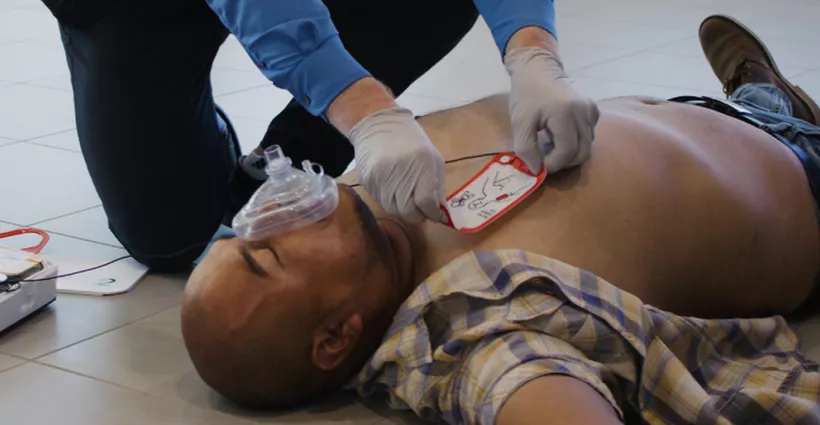The Beginner’s Guide to CPR and AED

Teach Your Child to Call 112
June 30, 2023Emergency Care
Cardiac arrest is a leading cause of death in the United States. It can often happen with little or no warning. This means bystanders, such as family members, coworkers and anyone nearby during a medical emergency, need to be prepared to respond and provide lifesaving care.
The combination of high-quality cardiopulmonary resuscitation (CPR) and early defibrillation with an AED is effective in saving lives when used in the first few minutes following collapse from sudden cardiac arrest.
In honor of National CPR and AED Awareness Week (June 1-7), let’s break down the basic steps of CPR and how to use an AED.
Basic CPR steps: Chest compressions save lives
Conventional CPR can restore limited oxygen to the brain and other vital organs via chest compressions and rescue breaths.
High-quality chest compressions are the foundation of effective CPR. To position yourself for CPR, kneel close to one side of the person’s chest. Place the heel of your hand on the center of the chest, on the lower half of the breastbone. Then, place the heel of the other hand on top of and parallel to the first. Be sure to stack your shoulders directly above your hands and straighten your arms to lock your elbows.
Once positioned, follow these basic CPR steps:
- Push hard and deep. Use your upper body weight to compress the chest at least two inches.
- Allow complete chest recoil. Lift all your weight off the person’s chest at the end of each compression.
- Push fast. Compress the chest at a rate of 100-120 compressions per minute.

Trained CPR providers who are willing and able should also perform rescue breathing using a barrier device. Rescue breaths are an important component for successful resuscitation.
However, if you don’t have personal protective equipment (e.g. pocket mask) or aren’t CPR trained, you can still help by calling 911 and providing compression-only CPR.
How to use an AED
Automatic external defibrillators are designed to deliver an electrical shock to restore the heart’s normal contractions. Although each AED might look different depending on its model and manufacturer, they all operate in a similar manner.
To use an AED, follow these simple steps:
- Power on the AED. This might include opening the lid or pressing a power button.
- Bare the victim’s chest. The AED needs direct contact between the pads and the person’s skin, so remove any clothing that’s in the way.
- Apply the AED pads. The pads have pictures on them to show proper placement.
- Allow AED analysis. When the AED prompts you, clear the person by ensuring no one is touching them.
- Clear the person and deliver a shock. If the AED advises a shock, loudly say “Everybody clear,” and press the shock button.
Once a shock has been delivered, immediately resume CPR starting with chest compressions. The AED will continue to periodically analyze the heart rhythm and provide voice prompts.
Take a CPR training course near you
High-quality CPR and early AED use can more than double the likelihood of survival for SCA victims. But many people hesitate to intervene due to fear of doing the wrong thing or assuming someone else will act.
Emergency care training can give you the confidence to respond during a sudden cardiac arrest emergency, as well as a variety of other medical emergencies. Find CPR, AED and First Aid Training Course.
Original post: HSI


